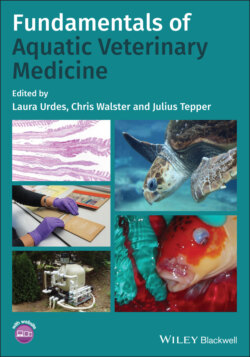Читать книгу Fundamentals of Aquatic Veterinary Medicine - Группа авторов - Страница 25
1.3.1.2 Ultraviolet Filtration
ОглавлениеPathogens can be removed effectively from water by UV filtration. These filters cause DNA damage to microorganisms by radiating with light in the UV‐C spectrum. The dose required to inactivate an organism varies, with some organisms proving more difficult and thus requiring a higher dose than others. Published values for specific pathogens can be found and may vary with the system used, the source of water, species being reared, and the potential pathogens of concern. These doses are calculated under ideal laboratory conditions and, in reality, the effective dose required may be much higher in a system with poor water quality. UV filters consist of a light source (bulbs) contained within a vessel that permits water to be passed through at varying rates. The amount of time the water is in contact with the light and the wattage of the bulb determines the dose. These systems are subject to impacts from turbidity of the water and require regular maintenance to remain effective. The glass must be cleaned of debris and silt and most manufacturers recommend bulb replacement at a minimum of once a year. Water with a high organic load will reflect the UV radiation and cause a decline in the effective dose. Systems with high total solid loads or otherwise high in organics may require prefiltration to assure reliable UV effectiveness. Flows must be monitored and not increased to exceed the capabilities of the UV filter.
Other factors that may impact the dose requirements for pathogen inactivation in a system are the bacterial repair mechanisms – photoreactivation and dark repair – that may allow bacteria to resist being killed by repairing the UV damage. Preventing exposure of the water to natural light will help to inhibit photoreactivation of bacteria in the system, as will increasing the UV dose in the system beyond the standard published doses. Preventing reduction of lamp intensity, which can occur with poor water quality or increased flow, will also help to reduce photoreactivation in the system. In cold‐water aquaculture with short water retention times, photoreactivation is more likely to become a problem than dark repair. Likewise, in recirculating systems that have long water retention times (many cycles of the same water or a high reuse percentage with very few additions of new water) dark repair may be more of a concern. UV filtration at lower doses is often employed in aquasystems for planktonic algae control (using a UV light unit).
